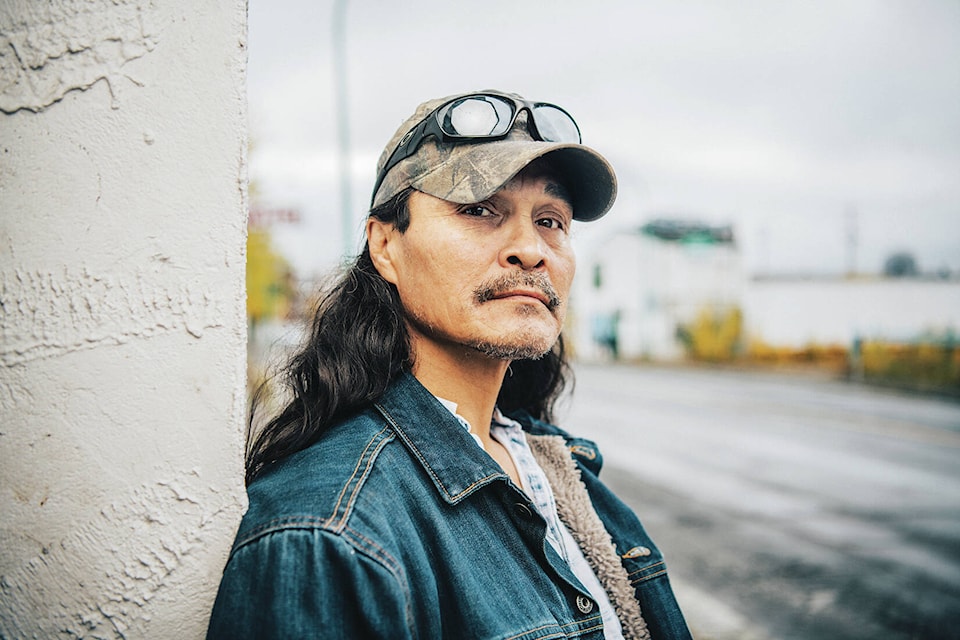Your eyes open slowly after a fitful sleep, your face is swollen, numb. The nylon tent is no match for bone-chilling, minus-thirty temperatures where each warm breath rises and crystallizes. “By morning, you’ve got frostbite on your face,” says Michael Fatt as he remembers his life in tent cities on the outskirts of downtown.
Neither of Yellowknife’s overnight shelters allowed couples, so Fatt and his wife sometimes slept together in tents. Or anywhere with a roof. “I’ve slept in every part of buildings,” he says. “I’ve slept in little cubby holes that had dirt in them and little storage units.”
That was 12 years ago.
“It came to a point where it was just too much, I thought I was going to die and I didn’t want to die like that,” says Fatt, who is now 55, has a home with his wife and runs Common Ground, a program that employs street-involved people. He’s also a vocal advocate for opening a new temporary day shelter at the corner of Franklin Avenue and 48th Street before the temperatures plunge.
“These temporary shelters are life-saving. I’ve picked people up out of snowbanks sleeping and I got them into a shelter—they’re literally trembling and they’re so weak and…oh man…they’re just refrigerated. It’s an unbearable kind of thing to even witness,” he says. “But at the end of the day once you start drinking you don’t care, because that’s less pain than enduring the feeling that you’re feeling, the hurt and the pain.”
An addictions treatment program in Calgary helped Fatt recover from booze and drugs, but as a survivor of the Sixties Scoop—the mass removal of Indigenous infants from their families into the Child Welfare system between 1961 and the 1980s—there is no way to recover the losses that drove him to substance abuse.
Taken from his family as a baby in Fort Resolution, he lived in an orphanage, was sent south for adoption, then shuffled between foster homes where, as the only Indigenous child in predominantly white neighbourhoods, he faced mountains of racism.
“I grew up with loss all my life. I lost my entire family, so I suffered a lot of stuff that I’m still coming out of today,” Fatt says. “A lot of people are coming back from the Sixties Scoop, and they’re on the streets now because they don’t know how to make it at home, because they’ve already suffered the loss of those families.”
Fatt says a temporary day shelter at 4709 Franklin Avenue, the building recently used by Aurora Village, must open its door for the most vulnerable because so much of society continues to shut them out.
Health and Social Services Minister Julie Green has appealed for public support of the new temporary day shelter location. Green says before the COVID-19 outbreak forced the Sobering Centre and Day Shelter on 50th Street to close, pandemic restrictions had reduced its capacity to just 20. Without additional shelter space, she says this winter 300-plus people experiencing homelessness in Yellowknife will be forced into businesses, stairwells and hallways between 7 a.m. and 7 p.m., when overnight shelters are closed.
“I want to stress that the temporary day shelter is just that, temporary, and it’s not a sobering centre or a place where people stay overnight,” Green says. “But it’s the only location available now that can meet the very immediate and critical needs of this downtown population.” Her department plans to locate a permanent Wellness and Recovery Centre downtown by 2024.
Katelyn Gibbons was a team leader at the previous day shelter in the Mine Rescue Building, where there were lineups each morning when the doors opened at 7:30.
“Depending on how many people are outside, we have to rotate people so others can come in and use the bathroom or shower,” she says.
“When you have a shelter, you can actually help people and have a place for them to go so you’re not seeing people out on the streets or sleeping in the banks or at the post office,” she says. The day shelter provides a warm place to grab a cup of coffee, a meal, safely take a nap, or do laundry. But those who work there say most importantly, it’s a place to feel cared for.
“A lot of these folks have never had anybody actually care for them, and it’s amazing what that does,” says Merrill Cooper, a registered nurse who provides basic healthcare services on the streets and in shelters: blood work, wound care, monitoring chronic conditions, even walking people to doctor’s appointments or helping them access counselling or rehab.
“The goal was to meet people where they’re at and bring healthcare to them,” says Cooper. Unless peoples’ basic needs are met, she says no one can strive to heal themselves from the intergenerational traumas of being separated from their families and cultures through the Sixties Scoop or residential schools. “I can’t imagine having your child taken from you and never seeing it again…I can’t even…I would not be a functioning human being.”
Fatt implores Yellowknifers to change the “us versus them mentality” that treats people without homes like they are subhuman. “We gotta let the city know that that is us, these are our people. If we want them to get off the streets, we want to encourage and inspire and honour them.”
